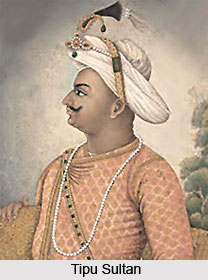 Between 27th to 28th January 1790, Lord Cornwallis issued orders to the Government of Madras and the Resident to the Court of the Nizam of Hyderabad to commence hostilities against Tipu Sultan, the ruler of Mysore. This followed Tipu`s invasion on December 29, 1789 of Travancore and the Carnatic and his attacks on the convoys of General William Medows (1738-1813).
Between 27th to 28th January 1790, Lord Cornwallis issued orders to the Government of Madras and the Resident to the Court of the Nizam of Hyderabad to commence hostilities against Tipu Sultan, the ruler of Mysore. This followed Tipu`s invasion on December 29, 1789 of Travancore and the Carnatic and his attacks on the convoys of General William Medows (1738-1813).
On 29th January 1791, Lord Cornwallis took command of the Company forces facing Tipu Sultan. His plans called for his attack on Tipu from the east and for General Sir Robert Abercromby (1740-1827), Governor and Commander-in-Chief of Bombay, to join him at Seringapatam from the west. The Third Mysore War was thus ensued by the British, on a pretty frivolous issue. On 7th March, Lord Cornwallis captured the city of Bangalore and then, on March 21st, took possession of the fort. Bangalore proved to be a major supply point in preparation for a siege of Seringapatam.
On 13th May, the British routed Tipu`s forces in Arrakerry, but a lack of supplies prevented a follow-up advance. On 26th May, Cornwallis initiated his retreat from Bangalore. He had failed to make a juncture with Abercromby from the Malabar Coast and his supplies and transport suffered greatly from the onset of the spring monsoon. Following the monsoon, Lord Cornwallis secured his lines of communications with the capture of the hill forts of Nundydroog, Sevendroog and Outradroog.
On 6th and 7th February 1792, Lord Cornwallis launched his attack on Tipu Sultan and drove him into the fortress at Seringapatam. On 18th March, a Treaty of Seringapatam was agreed upon by Lord Cornwallis and Tipu Sultan. The terms inclouded were: Tipu`s payment of three million pounds, his cessation of half of Mysore (Malabar and Palghat), and the sending of two of Tipu`s sons as hostages to Cornwallis. Thus ended the Third Mysore War, making much lasting impact. The war resulted in a sharp curtailment of Mysore`s borders. This stood as an advantage for the Marathas, the Nizam of Hyderabad and the Madras Presidency. The districts of Malabar, Salem, Bellary and Anantapur were relinquished to Madras Presidency.



















